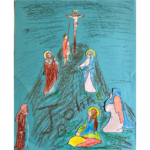
Teresa Ali Fatim Corella Sanchez de Cepeda Davila y Ahumeda born on March 28, 1515 in Avila, Spain, the third child in a family of 9 children, became known simply as St. Teresa of Avila!
Her father Don Alfonso, a wealthy wool merchant and her mother Dona Beatriz, both carried ‘big names’ that speak of a high position in Avila.
Teresa was brought up in a pious, Christian environment, surrounded by stories of saints and martyrs. When she was 7, together with her brother Roderigo, she ran away from home, planning to beg like the poor friars, hoping to become martyrs at the hands of the Moors. They were found by their uncle who brought them back home to the relief of all! At another time they decided to live like hermits, so they built cells of twigs and stones in their garden!
When Teresa was 14 years old, her outlook on life changed when her mother died. She put herself under the protection of Our Lady, beseeching her to be her mother. Soon after, her outlook on life steered on a different path after befriending one of her cousins. She was caught up in tales of chivalry and romance, indulging in following fashion, pampering herself in fine clothes, perfume and jewelry.
Noticing these changes in his daughter’s personality, her father decided to put his daughter with the Augustinian nuns to be educated. But after eighteen months, Teresa suffered a severe bout of malaria. She was sent home to live with her eldest sister in the country. It was during this period in her life that she decided to join the Carmelites. As her father did not give his consent, she went secretly to the Convent of the Incarnation, outside Avila, where she was admitted.
After her profession, Teresa, became gravely ill and once again she had to return home. It was only after 3 years, during which time she hovered between life and death that she returned to the convent where life was quite pleasant! The nuns had private apartments, wore jewelry, kept pets and were allowed all kinds of visitors. She found pleasure in being with people who admired her intelligence and charming personality.
She started to become aware that these practices were driving her away from the practice of prayer and from seeking union with God. When her practice of mental prayer deepened, she was enriched with spiritual experiences that were often diagnosed as possible delusions.
But these deep insights led her to a decision to reform the Carmelite Order. However, her efforts at reform were met with opposition as she continued to be misunderstood and judged harshly.
By the time she was 43 , supported by her Spiritual Director, she became determined to found a new convent based on a simple life and prayer: the basics of the contemplative Carmelite Order. Her followers became known as the Discalced Carmelites as they went barefoot or just wearing scanty sandals. Eventually, by the support of St. John of the Cross, then a young priest, a male counterpart of Discalced Carmelites, was also founded.
Undaunted by the hardships of travel of those times she travelled from Spain through Portugal as far as the Mediterranean, crossing mountains and rivers, over poor roads, staying in rough lodgings and thriving on meagre food, so that by the time of her death at the age of 67, she had established 16 convents.
St. Teresa of Avila has been described as ‘ a mystic’ because through her deep mental prayer she experienced ‘a profound loving union with God.’
She has also been declared ‘Doctor of the Church’ not only for her ‘exemplary holiness’ but because her doctrinal writings contributed significatly to the Doctrine of the Church.












